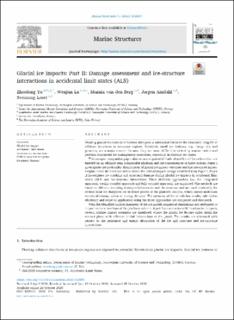| dc.contributor.author | Yu, Zhaolong | |
| dc.contributor.author | Lu, Wenjun | |
| dc.contributor.author | van den Berg, Marnix | |
| dc.contributor.author | Amdahl, Jørgen | |
| dc.contributor.author | Løset, Sveinung | |
| dc.date.accessioned | 2021-01-15T12:23:35Z | |
| dc.date.available | 2021-01-15T12:23:35Z | |
| dc.date.created | 2020-11-01T14:19:31Z | |
| dc.date.issued | 2021 | |
| dc.identifier.issn | 0951-8339 | |
| dc.identifier.uri | https://hdl.handle.net/11250/2723273 | |
| dc.description.abstract | Floating glacial ice features of various sizes pose a substantial threat to the structural integrity of offshore structures in ice-prone regions. Relatively small ice feathers, e.g., bergy bits and growlers, are a major concern because they are more difficult to detect by marine radars and perform concurrent ice management operations, especially in extreme sea states.
This two-part companion paper aims to assess potential loads of accidental ice actions that are exerted on an offshore semi-submersible platform and the consequences of these actions. Paper I investigates the probability distributions of glacial ice impact velocities and the associated impact heights under different sea states. Given the critical impact energy identified from Paper I, Paper II investigates ice crushing and structural damage during glacial ice impacts in accidental limit states (ALS) and ice-structure interactions. Three different approaches, i.e., the integrated approach, weakly coupled approach and fully coupled approach, are employed. The methods are based on different coupling strategies between ice and the structure and are used to identify the critical local ice sharpness for stiffened panels of the platform column, which causes maximum structural damage given an energy demand. The accuracy of the simulation results, calculation efficiency and scope of application using the three approaches are compared and discussed.
With the identified critical sharpness of the ice model, numerical simulations are performed to impact various locations of the platform column. Apart from scenarios with head-on ice impacts, several oblique impact scenarios are simulated, where the glacial ice feature slides along the contact plane with different initial indentations of the panel. The results are discussed with respect to the resistance and energy absorption of the ice and structure and ice-structure interactions. | en_US |
| dc.language.iso | eng | en_US |
| dc.publisher | Elsevier | en_US |
| dc.relation.uri | https://www.sciencedirect.com/science/article/pii/S0951833920301829 | |
| dc.rights | Navngivelse 4.0 Internasjonal | * |
| dc.rights.uri | http://creativecommons.org/licenses/by/4.0/deed.no | * |
| dc.subject | Arktisk teknologi | en_US |
| dc.subject | Arctic Technology | en_US |
| dc.title | Glacial ice impacts: Part II: Damage assessment and ice-structure interactions in accidental limit states (ALS) | en_US |
| dc.type | Peer reviewed | en_US |
| dc.type | Journal article | en_US |
| dc.description.version | publishedVersion | en_US |
| dc.subject.nsi | VDP::Offshoreteknologi: 581 | en_US |
| dc.subject.nsi | VDP::Offshore technology: 581 | en_US |
| dc.source.volume | 75 | en_US |
| dc.source.journal | Marine Structures | en_US |
| dc.identifier.doi | 10.1016/j.marstruc.2020.102889 | |
| dc.identifier.cristin | 1843889 | |
| dc.relation.project | Notur/NorStore: NN9585K | en_US |
| dc.relation.project | Norges forskningsråd: 223254 | en_US |
| dc.description.localcode | © 2020 The Author(s). Published by Elsevier Ltd. This is an open access article under the CC BY license(http://creativecommons.org/licenses/by/4.0/) | en_US |
| cristin.ispublished | true | |
| cristin.fulltext | original | |
| cristin.qualitycode | 2 | |

